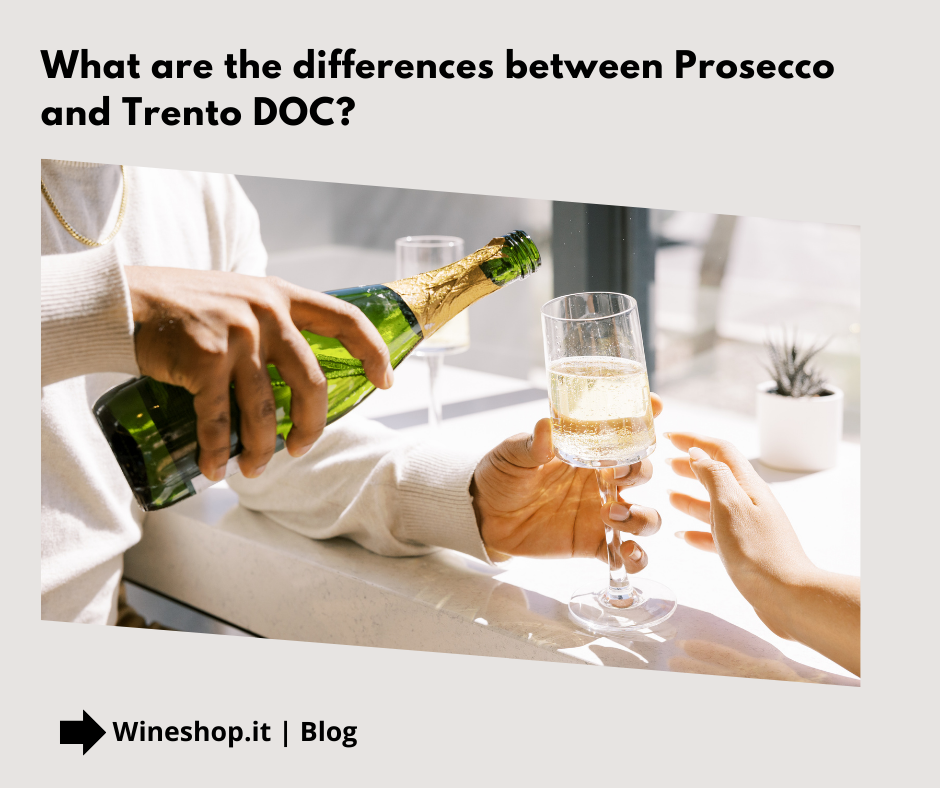What are the differences between Prosecco and Trento DOC?
The world of Italian sparkling wines is made up of different appellations that have different production methods. This is, for example, the case of Prosecco and Trento DOC. Two Italian bubbles that are often confused or considered to have the same characteristics, but which, in reality, are very different from each other.
Now we will explain the main differences between these two great italian sparkling wines.
The differences between Prosecco and Trento D.O.C.
The main differences between Prosecco and Trento DOC can be grouped into 4 categories:
1. production method;
2. grape varieties;
3. area of production and cultivation of the grapes;
4. organoleptic properties of the wines.
Below, for each of these aspects, we highlight the specific differences between these two wines and denominations. At the end of the article, you will have a general overview of their key features and will have no problem distinguishing them.
1️⃣ Production method
The first difference between Prosecco and Trento DOC is the production method. In particular, the two wines are distinguished by a different method of sparkling wine production, i.e. the process of transformation of the base wine into sparkling wine, through a second fermentation and the formation of the classic foam and perlage of bubbles.
Prosecco is usually produced with the Martinotti or Charmat method, that method of sparkling wine production characterized by the second fermentation in an autoclave.
It is important to make two further clarifications about Prosecco.
1. Prosecco is the name of a D.O.P. (D.O.C. in the italian classification) to which over time two other specific appellations have been added: Conegliano Valdobbiadene - Prosecco and Colli Asolani - Prosecco.
2. Prosecco, unlike what many people think, is not just a sparkling wine. Among the types of Prosecco there are also still versions, which are much less widespread and well-known.
Trento DOC, on the other hand, is exclusively a sparkling wine produced through the sparkling process called the Classic method or Champenois method, characterized by the second fermentation in the bottle. The D.O.C. Trento has an important record: it was the first Italian appellation to be reserved exclusively for sparkling wine obtained with the method of refermentation in the bottle, recognized on 9 July 1993.
2️⃣ Grape varieties
Let's now move on to another difference: the vines that are used for the production of these sparkling wines.
Prosecco must be obtained mainly from grapes of the Glera vine. Yes, because Prosecco is not the name of the grape variety. The grape variety is called Glera! The percentage of Glera grapes must be at least 85%. For the remaining 15% grapes from other vines can be used.
Trento D.O.C. sparkling wines can be obtained from the grapes of the Chardonnay and/or Pinot bianco and/or Pinot noir and/or Meunier vines, alone or together.
3️⃣ Area of production and cultivation of the grapes
The third key difference concerns the area in which the grapes are grown.
Prosecco is produced in north-eastern Italy, in Veneto and Friuli Venezia Giulia, in the area that includes the provinces of Belluno, Gorizia, Padua, Pordenone, Treviso, Trieste, Udine, Venice and Vicenza.
Trento D.O.C. is produced in Trentino Alto Adige, also in the north-east of Italy, in some municipalities in the province of Trento, as the name of the appellation suggests.
4️⃣ Organoleptic properties
The different production method, the different terroir and the different grapes used determine the production of wines with different qualities and organoleptic characteristics.
Prosecco is characterized by a delicate and fine aroma, floral notes of white flowers and fruity notes (apple, pear, exotic fruit and citrus fruits). On the palate it has good flavor, freshness and liveliness. Due to these characteristics, Prosecco wines are perfect for an aperitif and to accompany unstructured fish dishes.
Trento DOC has greater olfactory and gustatory complexity. This wine must age on fermentation yeasts for at least 15 months! This influences its organoleptic qualities. On the nose there are fruity hints, enriched by hints of yeast, notes of toasted bread and almondy sensations, spicy in the "Riserva" versions. On the palate it is more structured than Prosecco, very balanced and harmonious, with a fresh-acid component that makes the sip even more pleasant.
Did you know all these differences between Prosecco and Trento DOC?
If you liked our article and if you want to continue to receive news, updates and curiosities about the world of wine, subscribe to the Wineshop.it wine newsletter. Lots of content and offers await you!









